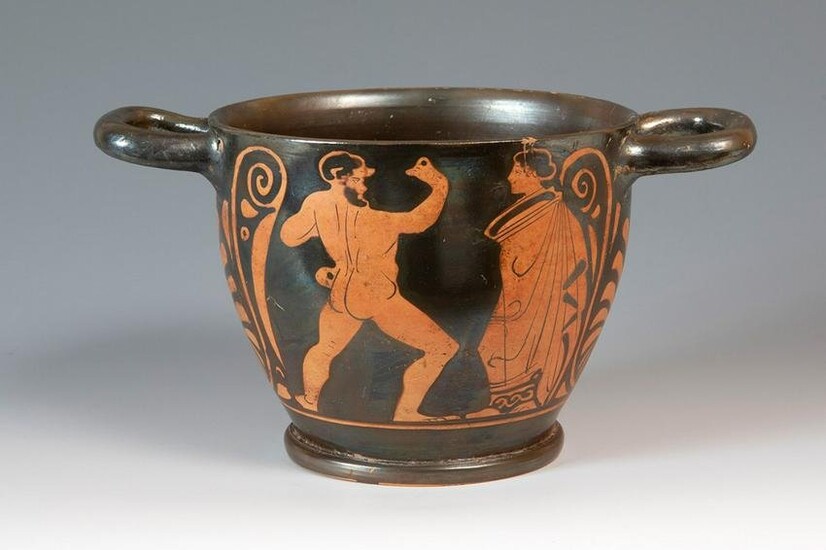Skyphos with satyr and maenad. Ancient Greece, Attica
Skyphos with satyr and maenad. Ancient Greece, Attica, 5th century BC.
Ceramics
Provenance: private collection J.Martà , Barcelona. Formerly in an English private collection.
Thermoluminescence test attached.
Conservation: Minimal nick on the upper lip, intact and with excellent conservation of the glaze.
Measurements: 12 cm. high and 23 cm. diameter between handles.
Skyphos decorated with two characters from the Bacchic entourage (a maenad and a satyr), using the red-figure technique. Red-figure ware was one of the most important figurative styles in Greek production. It developed in Athens around 530 BC, and was used until the 3rd century BC. It replaced the previous predominant style of black-figure ware within a few decades. The technical basis was the same in both cases, but in the red figures the colouring is inverted, with the figures highlighted against a dark background, as if illuminated by a theatrical light, following a more natural pattern. Painters working with black figures were forced to keep the motifs well separated from each other and to limit the complexity of the illustration. The red-figure technique, on the other hand, allowed greater freedom. Each figure was silhouetted against a black background, allowing the painters to portray anatomical details with greater accuracy and variety. The technique consisted of painting the motifs on the still-wet piece, using a transparent varnish which, when fired, took on an intense black hue. The motifs were therefore invisible before firing, which meant that the painters had to work entirely from memory, unable to see their previous work. Once the piece was fired, the unglazed areas remained with the reddish hue of the clay, while the glazed, "painted" areas took on a dense, glossy black colour.
Estimate
Time, Location
Auction House
Skyphos with satyr and maenad. Ancient Greece, Attica, 5th century BC.
Ceramics
Provenance: private collection J.Martà , Barcelona. Formerly in an English private collection.
Thermoluminescence test attached.
Conservation: Minimal nick on the upper lip, intact and with excellent conservation of the glaze.
Measurements: 12 cm. high and 23 cm. diameter between handles.
Skyphos decorated with two characters from the Bacchic entourage (a maenad and a satyr), using the red-figure technique. Red-figure ware was one of the most important figurative styles in Greek production. It developed in Athens around 530 BC, and was used until the 3rd century BC. It replaced the previous predominant style of black-figure ware within a few decades. The technical basis was the same in both cases, but in the red figures the colouring is inverted, with the figures highlighted against a dark background, as if illuminated by a theatrical light, following a more natural pattern. Painters working with black figures were forced to keep the motifs well separated from each other and to limit the complexity of the illustration. The red-figure technique, on the other hand, allowed greater freedom. Each figure was silhouetted against a black background, allowing the painters to portray anatomical details with greater accuracy and variety. The technique consisted of painting the motifs on the still-wet piece, using a transparent varnish which, when fired, took on an intense black hue. The motifs were therefore invisible before firing, which meant that the painters had to work entirely from memory, unable to see their previous work. Once the piece was fired, the unglazed areas remained with the reddish hue of the clay, while the glazed, "painted" areas took on a dense, glossy black colour.



